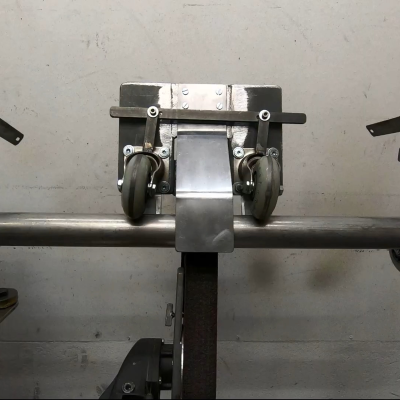Can I just say that doing a links roundup article in a week that includes April Fool’s Day isn’t a fun job? Because it’s not. I mean, how can you take something like reports of X-rays flowing from Uranus seriously when they release the report on such a day? It sure looks like a legitimate story, though, and a pretty interesting one. Planets emitting X-rays isn’t really a new thing; we’ve known that Jupiter and Saturn are both powerful X-ray sources for decades. Even though Uranus is the odd child of our solar system, finding evidence for X-ray emissions buried in data captured by the Chandra observatory in 2007 was unexpected. Astronomers think the X-rays might be coming from Uranus’ rings, or they might be reflections of X-rays streaming out from the sun. Or, it might be the weird alignment of the gas giant’s magnetic field causing powerful aurorae that glow in the X-ray part of the spectrum. Whatever it is, it’s weird and beautiful, which all things considered isn’t a bad way for things to be.
Another potential jest-based story popped up this week about the seemingly impossible “EmDrive”. It seems that when you appear to be breaking the laws of physics, you’re probably doing it wrong, and careful lab tests showed that fuel-free propulsion isn’t here yet. One would think it was self-obvious that filling a closed asymmetrical chamber with microwaves would produce absolutely no thrust, but EmDrive proponents have reported small but measurable amounts of thrust from the improbable engine for years. A team at TU Dresden found otherwise, though. Even though they were able to measure a displacement of the engine, it appears to be from the test stand heating up and warping as the RF energy flowed into the drive chamber. By changing the way the engine was supported, they were able to cancel out the dimensional changes that were making it look like the EmDrive was actually working.
 Want to use surface-mount parts, but don’t want to bother spinning up an SMD board? Not a problem, at least if you follow the lead of David Buchanan and perform no-surface surface-mount prototyping. We stumbled upon this on Twitter and thought it looked cool — it’s got a little bit of a circuit sculpture feeling, and we like the old-school look of plain 0.1″ perfboard. David reports that the flying leads are just enameled magnet wire; having done our share of scraping and cleaning magnet wire prior to soldering, we figured that part of the build must have been painful. We pinged David and asked if he had any shortcuts for prepping magnet wire, but alas, he says he just used a hot blob of solder and a little patience while the enamel cooked off. We still really like the style of this build, and we applaud the effort.
Want to use surface-mount parts, but don’t want to bother spinning up an SMD board? Not a problem, at least if you follow the lead of David Buchanan and perform no-surface surface-mount prototyping. We stumbled upon this on Twitter and thought it looked cool — it’s got a little bit of a circuit sculpture feeling, and we like the old-school look of plain 0.1″ perfboard. David reports that the flying leads are just enameled magnet wire; having done our share of scraping and cleaning magnet wire prior to soldering, we figured that part of the build must have been painful. We pinged David and asked if he had any shortcuts for prepping magnet wire, but alas, he says he just used a hot blob of solder and a little patience while the enamel cooked off. We still really like the style of this build, and we applaud the effort.
Speaking of stumbling across things, that’s one of the great joys of this job — falling down algorithmically generated rabbit holes as we troll about for the freshest hacks. One such serendipitous was this YouTube channel documenting a really nice jet engine build. We’ve seen plenty of jet engines before, but very few with afterburners like this one has. There’s also something deeply satisfying about the variable-throat nozzle that Praendy built for the engine — it’s a level of complexity that you don’t often see in hobbyist jet engines, and yet the mechanism is very simple and understandable.
 The other rabbit hole we discovered was after reporting on this cool TIG tungsten grinding tool. That took us into The Metalist’s back catalog, where we found a lot of interesting stuff. But the real treat was this automatic tube polisher (video), which we have to say kept us guessing up to the very end. If you’ve got 12 minutes and you enjoy metalworking builds at all, watch it and see if you’re not surprised by the cleverness of this tool.
The other rabbit hole we discovered was after reporting on this cool TIG tungsten grinding tool. That took us into The Metalist’s back catalog, where we found a lot of interesting stuff. But the real treat was this automatic tube polisher (video), which we have to say kept us guessing up to the very end. If you’ve got 12 minutes and you enjoy metalworking builds at all, watch it and see if you’re not surprised by the cleverness of this tool.
And finally, we had heard of the travails of Anatoli Bugorski before, but never in the detail presented in this disturbing video. (Embedded below.)
Who is Anatoli Bugorski, you ask? He is a Russian particle physicist who, while working in an accelerator lab in 1978, managed to get his head directly in the path of a 76 GeV proton beam. Despite getting a huge dose of radiation, Bugorski not only survived the accident but managed to finish his Ph.D. and went on to a long career in nuclear physics. He also got married and had a son. He was certainly injured — facial paralysis and partial deafness, mainly — but did not suffer anything like the gruesome fates of the Chernobyl firefighters or others receiving massive radiation doses. The video goes into some detail about how the accident happened — two light bulbs are better than one, it turns out. We enjoyed the video, but couldn’t stop thinking that Bugorski was the Russian atomic-age equivalent of Phineas Gage.
















I’d heard of Bugorski before, but just off hand. I think that he should be thankful that his accident involved a laser tight beam firing through his head rather than full body radiation. Like Phineas Gage the narrowness of the path through his head saved his life, but this video should still be shown to everyone on their first day at the particle accelerator!
Do not look into particle beam with remaining head.
What? No comments? Surely some sniggering at the back?
Keeping an eye out
Can’t we finally let go of Uranus and take a good hard look at Urectum?
Confiteor.
Tag: “magent” wire
It does look kinda pink-ish, no?
Dipping a fresh cut end of an enamel wire into a solder pot seems to be the only way to easily strip and tin it, every other method is doomed to be a painful endeavour.
I just put a drop of solder at the tip of the iron, and melt it in there. Clean up burnt enamel between fingernails, and maybe trim it a bit.
I use wire that isn’t enameled. #30 Kynar for W/W is silver plated and I have an old 3 lb spool of #40 “magnet wire” With wound cotton insulation and nothing else.
I think that Surfaceless Mount is a great idea.
Any tips on actually doing it?
I’m guessing one precuts the wires, and securely clamps the device, attaches the leads 1 by 1 until all are connected and then attach the other ends to the perfboard (hoping that no wires or leads break off in the process)?
We lay the wires in a jig aligned in a single orientation X or Y
Then we take a dremel tool with a polishing disc and swipe the enamel away from each wire in the jig along both sides
Place a tab of double sided tape trimmed thinner than the component across the wires
Generally, we then prime the wires with a solder paste syringe (been playing with conductive adhesives a bit)
Press the component into place
Heat gun
flip the chip and trim the crossover wires.
If its 4 sided like the one shown…..rotate 90 and repeat
Thanks!
The EmDrive test result’s more impressive than “we tested magic unicorn fart thruster, it doesn’t work” – they managed to get sensitivity down to nano-newton level, which is impressive. They’re actually at the point where they could test actual photon rocket thrust.
I had some 0.025″ (0.635mm) pitch solid copper ribbon cable for SCSI 2 cable. It was useful for soldering wires onto pads of an existing PCB. e.g. TQFP packages I have also tried using a machine socket as a base and solder bare wires (from stranded cable) to SMT pins. The socket can then be pulgged into DIP socket. I made a few PLCC socket to DIP for FLASH rom that way.
It is fine to do breakout for a few pins, but it takes too long. (I tried it at one point). These days, you can buy breakout board from China cheaply and it’ll save a lot of time than trying to strip/solder to the chip. Even etching a PCB would take less time than that.
thanks H.A.D. i finally understand references to Phineas and phrenology!
… could have used this info a few months ago but oh well …
it seems either Phineas never had a switching-back moment, or kept it to himself, as the return of emotions such as embarrasement are usually not admitted, ironically, due to embarrassement itself. maybe even desired to hide his final recovery and transition more gradually to normal social order, so as to avoid anyone noticing such changes, and thus avoid admitting any previous embarrassements as being embarrassements. this may have been mis-interpreted as lasting to his death and ultimately to the many falsities surrounding him.
the assumptions about adding structure to one’s life (such as work) aiding re-establishing links in the brain required for normal social function, rings true, for me at least; it may have been the most important.